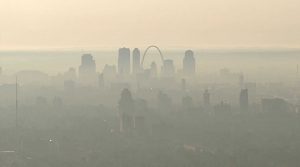According to a new report released by the U.S. Environmental Protection Agency (EPA), the St. Louis metropolitan area has failed to meet the agency’s most recent ozone standards as ozone levels remain too high. The report moves St. Louis City, St. Louis County, St. Charles County, Jefferson County and parts of Franklin County from the marginal to moderate ozone level category, with more than 20 other regions across the country also labeled under moderate ozone classifications.
As a result, the region will need to adopt the standards designated back in 2015 that set the ozone limit to 70 parts per billion in effort to preserve human health and the environment by the new attainment date of August 3, 2024. Since the latest data showed ozone levels in the St. Louis area at 71 parts per billion, the new regulations issued under the EPA’s reclassification for the region will help protect area residents while limiting the influence of the industries that are a leading source of air pollution.
The shift is due to an increase in ground-level ozone in the area, which arises when emissions from vehicles, power plants and other sources react with sunlight. This puts vulnerable populations – including children and teens, anyone 65 and older, people who work or exercise outdoors, and those with existing lung disease or cardiovascular disease – more at risk from long-term exposure to the gas at ground level that can lead to asthma and other respiratory illnesses. Additionally, the EPA’s report corresponds with findings from the American Lung Association’s 2022 “State of the Air” report, which graded St. Louis City, St. Louis County and St. Charles County with F’s for having recorded higher ozone levels during the years covered by the report (2018-2020).
With that in mind, the Clean Air Partnership encourages St. Louisans to continue their efforts to take voluntary steps to reduce emissions, as those actions play a critical role in improving air quality conditions and enhancing lung health in the region. One way individuals can show they care about clean air is by utilizing alternative modes of transportation, including transit, carpooling, vanpooling, walking, biking or telecommuting as often as they are able to help improve outcomes. Businesses and municipalities can also work collectively to reduce their environmental impact by introducing paperless policies, implementing a fully remote or hybrid schedule for employees to cut back on commuter emissions, installing electric vehicle charging stations or bike racks in parking structures to promote sustainable modes of transportation and more.
Changes at any level can help contribute to a greener and cleaner environment. Together, we can take small steps forward to bring the region into attainment and keep the air quality in healthier ranges. Additional air quality information and other tips to help clear the air can be accessed by visiting the Clean Air Partnership’s website, liking the Clean Air Partnership on Facebook or by following the organization on Twitter @gatewaycleanair. To access the full EPA report, visit epa.gov.

